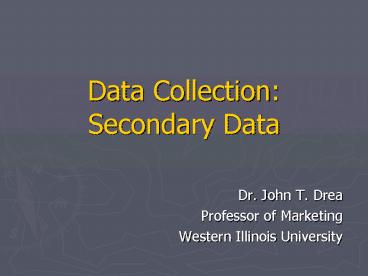Data Collection: Secondary Data PowerPoint PPT Presentation
1 / 13
Title: Data Collection: Secondary Data
1
Data Collection Secondary Data
- Dr. John T. Drea
- Professor of Marketing
- Western Illinois University
2
Secondary Data Defined
- Data that has been previously gathered by someone
other than the researcher and/or for some other
purpose than the one at hand.
3
Types of Secondary Data
- Internal Secondary Data data collected within
the firm, such as internal databases of customer
information. - External Secondary Data data obtained from
outside the firm - Published (data available for free from libraries
or trade associations) - Syndicated (specialized available for a fee to
subscribers - Nielsen, Arbitron are examples) - Databases (collection of inter-related data -
examples include business index, 1990 census,
directory data bases such as Dunn and Bradstreet)
4
Advantages of Secondary Data
- It can be obtained quickly.
- It is inexpensive (compared to primary data
collection.) - It is widely available.
- It can be effectively used to enhance primary
data collection (identify components for use in
the study)
5
Problems Associated w/ Secondary Data
- The measurement units may not match the
measurement units needed by the researcher. - Size of business, square footage vs. sales?
- Differing definitions used to classify the data.
- Ex SMM classifies data into three categories
- 20-34,999
- 35-49,999
- 50,000 and over
- What if you are targeting customers with 100,000
incomes and over? - These are problems of fit.
6
Problems Associated with Secondary Data
- How recent is the secondary data?
- Why is secondary data like fruits and vegetables?
- The time elapsed since the data was collected may
be a problem (ex census data) - The credibility of the data reported.
- Does it fit with what we already know?
- These are problems of accuracy.
7
Question to Ask About Secondary Data
- What was the purpose of the study? (some civic
groups overstate information to make communities
look more attractive) - Who collected the information? (competence of the
organization to do quality research) - What information was collected? (ex sales and
customers) - How was the information obtained? (sample and
size? Response rate? Validation?) - Is the information consistent with other
information?
8
North American Industrial Classification System
(NAICS)
- A classification system developed as a result of
NAFTA to replace SIC codes. - Allows for easier comparison of international
trade, industrial production, and labor
statistics - One change NAICS breaks services from one into
five categories Professional, Education, etc. - Groups the economy into 20 broad sectors, and
uses a six digit classification system (five
digits are standard, the sixth will be reserved
by each country for its own )
9
Survey of Buying Power
- Published by Sales and Marketing Management
magazine - Reports Effective Buying Income (EBI) and Buying
Power Index (BPI) - Can be very useful for estimating market
potential.
10
Creating a Customized BPI(Source Bush and
Burns, Marketing Research, 2nd edition)
Purpose Estimate demand for luxury cars in
Pensacola, FL.
Target Market Age 35 and earning over 50,000
per year
Needed Data Pensacola Age group, 35
(0.260.228)397,000 193,736 Total US
Population, 35 133,001,200 Pensacola
Automotive Sales 1,018,505,000 Total US Auto
Sales 605,127,843,000 Pensacola households
EBI, 50K (0.229)143,900 32,953 Total US
households EBI, 50K 29,134,500
11
Creating a Customized BPI(Source Bush and
Burns, Marketing Research, 2nd edition)
Next, calculate these figures as a of the US
total Age group 193736/133,001,200
0.14 Auto. Sales 1,018,505,000/605,127,843,0
00 0.16 EBI Households over 50K
32,953/29,134,500 0.113 Next, estimate the
importance of each for luxury car
sales Estimates Age group 30 EBI
60 Auto sales 10
12
Creating a Customized BPI(Source Bush and
Burns, Marketing Research, 2nd edition)
Now calculate the BPI for luxury cars using this
data BPI ( age group 0.3) ( EBI
households 0.6) ( auto sales 0.1) BPI
(0.14 x 0.3) (0.113 x 0.6) (0.16 0.1)
0.1258
This information can be compared against other
markets to see which has the greatest buying
power for luxury cars. It can also be used to
assess the sales potential for any given market
area.
13
Sales Potential for Luxury Cars in Pensacola
Total US luxury car sales Pensacola BPI
Pensacola sales potential If US
sales of luxury vehicles was estimated at
125,000,000,000 125,000,000,000 0.001258
157,250,000 sales of luxury vehicles in
Pensacola
This figure could then be compared to actual
sales in evaluating the dealership, once it is
open and operating.

